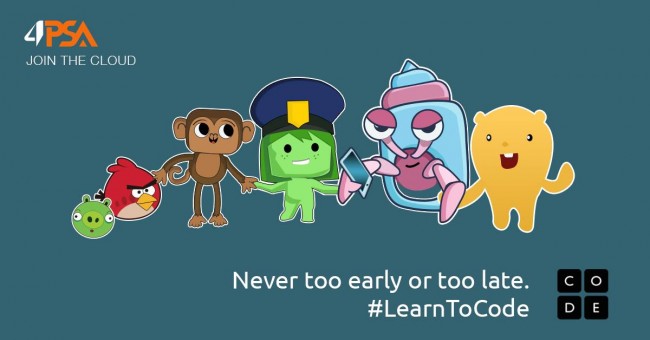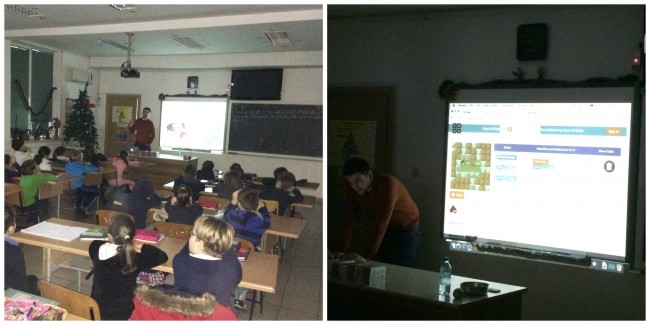A couple of weeks ago, I received an invitation on Facebook to attend Hour of Code Romania. I don’t usually pay attention to such notifications, but this one was somehow different, as the name got me thinking 🙂 I know what you can do with a line of code, but what does an hour of code represent?! This was enough to trigger my curiosity, so I did a little research.
Long story short. Hour of Code is a global movement that takes place in more than 180 countries during the Computer Science Education Week, 8-14 December, when teachers, NGOs, and companies try to reach out to as many students as possible and deliver an introductory computer science class. This isn’t just about technology companies, as 67% of software engineering jobs are outside the industry, in banking, retail, government, entertainment etc. Every student in every school should have the opportunity to learn computer science. Why? Because computer science and computer programming enable algorithmic thinking, boost analytical skills, and drive innovation. It’s code demystified in a world where 90% of the schools don’t offer programming classes, nor count computer science courses toward graduation. While, in the meantime, there are a whole lot more IT jobs available than students and this happens everywhere in the world. According to code.org, by 2020, only in US the gap will be 1,000,000 software engineers.
Big names in the technology world, entertainment industry, and even politics (who else 😉 ) support this movement by using their influence, delivering computer science classes, and making donations. And this is where 4PSA Clouders stepped in.
Clouders’ Way
We strongly believe that technology can and will improve our lives, if it’s used the right way. The future belongs to those who know how to control it and benefit from its ever-growing power. This might sound like a bad science fiction movie from the 90’s, but it’s actually not: learn how to control technology, so it doesn’t control you! This is already happening in our smartphone, Wi-Fi driven world.
Just picture this: an eight year old boy with the tablet in his hand. Tap here, tap there – everything’s at his fingertips. Now, imagine him at his desk, solving a maths problem. Not the simplest problem, but, still, doable. And yet, he needs a little time to think it over, to try various options and then, when it’s finally solved in his head, he has to put it in the mathematical form. Not instantaneous anymore! So, are you surprised that he doesn’t have enough patience for anything else but his tablet?!
What if your kid knew what’s hidden behind those Angry Birds, Minecraft, Talking Tom games he enjoys playing so much? Or how many lines of code you need in order to be able to check in with your friends at the movies?! Or how much storage Instagram uses for all those like-able pictures?! I’m not even mentioning the miraculous instant messages that vanish into thin air inside Snapchat 😉 No, most kids don’t know that, but we could make them curious. Cause this is how everything begins…
curiosity mood... on
tackle imagination... start
use your brain... restart
find the right path... --force
I made it myself... [ OK ]
If schools and the educational system don’t understand that, we, the community should open their eyes and teach them. As it is never too early, nor to late to learn!
#HourOfCode with 4PSA
This is how it all started. We found out about the world-wide Hour of Code movement and shared it with the team. A couple of Clouders volunteered to deliver an Hour of Code at a school in our headquarters’ city, Bucharest. Three and four graders.
We packed in our knowledge, chose several tutorials from http://ro.code.org/learn, unleashed our joie de vivre and off we went on a rainy December day to meet the young padawans. And everything that unfolded was way beyond our wildest imagination 🙂
Our goal was to take the children for a journey in the beautiful world of algorithms and software engineering. We wanted to show them there is more behind tablets/smartphones/computers than just nice games and social networks. They had millions of questions and, had the class not been over, they would have stayed there for hours and hours asking us more. They were spontaneous, challenging, fast, full of joy, and extremely refreshing. And suddenly, the cold winter rain became a summer shower 🙂
They proved to us once again that the curiosity and desire to know more are great drivers for passion. And passion for software engineering can be awaken early and last for a lifetime. This is a precious lesson. Thank you, children!


1 Comment
You can post comments in this post.
What computer languages did you use to teach. My favorite was APL.
Edward Sansom 10 years ago
Post A Reply